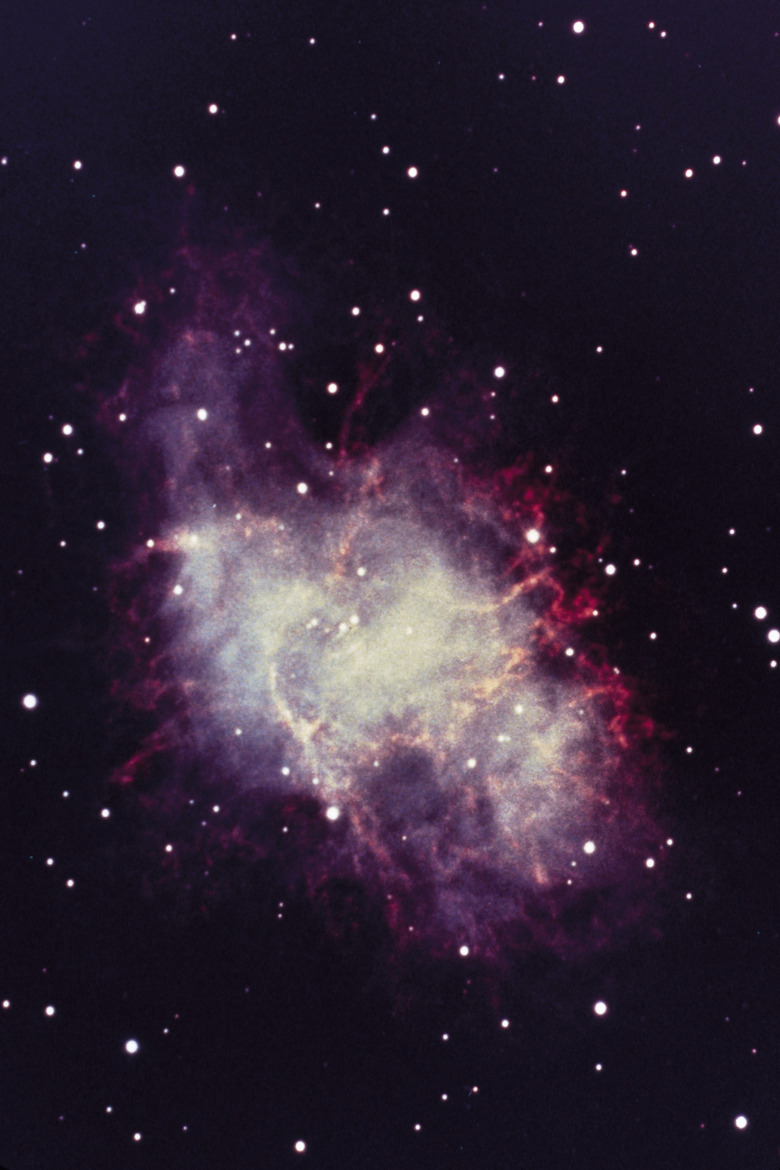Science Project On The Life Cycles Of Stars
A star's life cycle varies depending on its mass. You can represent the life cycle of a typical smaller star like our sun with a series of five plastic globes illuminated by Christmas bulbs. On a piece of thin plywood, space the globes evenly from left to right in this order, based on their diameter — 6 inches, 8 inches, 7 inches, 10 inches and 6 inches. Draw a circle around each globe. Remove the globes and drill a 1.5-inch hole in the center of each circle. Arrange a string of Christmas bulbs in the following left-to-right sequence: white, orange, yellow, red, red. Poke each bulb up through the appropriate hole and secure the cord to the plywood with duct tape. Place the globes over the bulbs before displaying your exhibit.
Protostar
Protostar
A star begins its life in a nebula, which is a cloud of hydrogen, helium and interstellar dust. As atoms within the nebula clump together under the influence of gravity, a protostar begins to take shape. To represent a protostar, place a 6-inch globe over the white bulb on the far left. Glue wisps of cotton to the outside of the globe to represent the gas cloud surrounding the protostar's core. For additional detail, sprinkle silver glitter over the cotton.
Newborn Star
Newborn Star
As a protostar becomes denser, its core grows hotter. Once it gets hot enough to begin burning hydrogen, it becomes a true star. Put the 8-inch globe over the orange bulb to represent a newly formed star.
Stable Star
Stable Star
When the gas pressure generated by nuclear fusion in the star's core counterbalances the effect of gravity, the star achieves equilibrium. During this stage, the star shines steadily as it burns its supply of hydrogen. Our sun is in this stage; scientists predict it will remain stable for another 10 billion years. Place the 7-inch globe over the yellow bulb to represent the smaller, hotter stable star.
Red Giant
Red Giant
As the hydrogen fuel in a star's core runs out, the loss of equilibrium causes the core to collapse. The core grows hotter as its density increases; this causes the outer regions of the star to expand and cool. Scientists believe that when our sun becomes a red giant, it will expand into Earth's orbit. Place the 10-inch globe over the first red bulb to represent the red giant stage.
Planetary Nebula
Planetary Nebula
As the red giant's outer layers and ejected matter disperse, they form a shell around the dying star's dense core; this is known as a planetary nebula. To represent this stage, wrap crumpled tissue paper around the second 6-inch globe and place it over the second red bulb.
White Dwarf
White Dwarf
A medium-size star like our sun is likely to collapse into a tiny, dense white dwarf, which will continue to glow faintly because of residual heat from earlier stages in its life cycle. Represent the white dwarf by gluing a 1-inch white marble to the right side of the plywood sheet.
Cite This Article
MLA
Swan, David. "Science Project On The Life Cycles Of Stars" sciencing.com, https://www.sciencing.com/science-project-life-cycles-stars-12176065/. 24 April 2017.
APA
Swan, David. (2017, April 24). Science Project On The Life Cycles Of Stars. sciencing.com. Retrieved from https://www.sciencing.com/science-project-life-cycles-stars-12176065/
Chicago
Swan, David. Science Project On The Life Cycles Of Stars last modified August 30, 2022. https://www.sciencing.com/science-project-life-cycles-stars-12176065/
